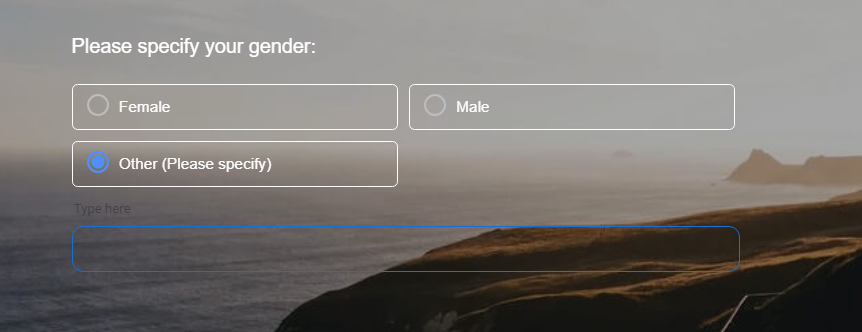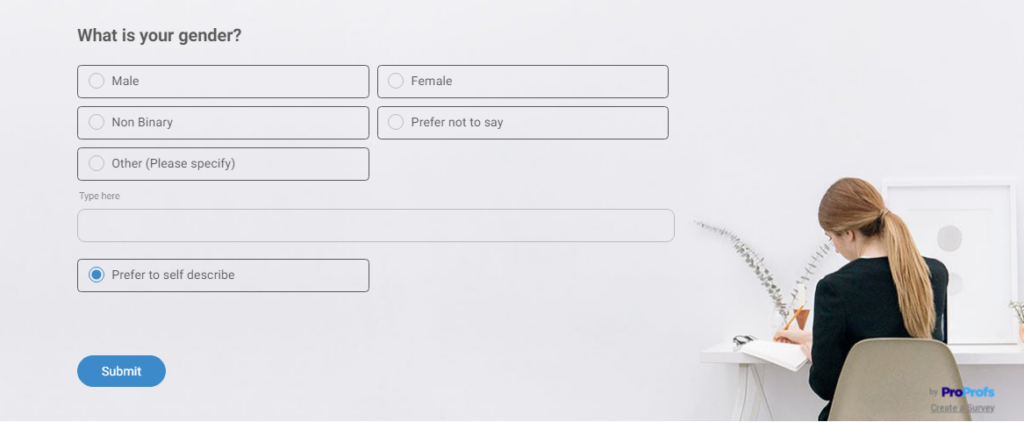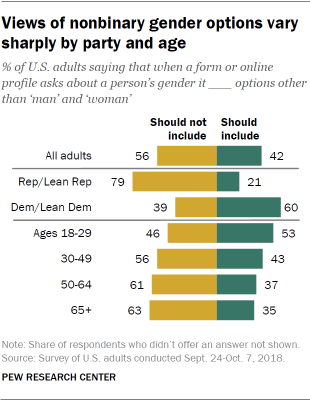
Have you ever felt the frustration of trying to fit yourself into a box that doesn’t quite capture who you are?
Now, imagine encountering this every time you take a survey. As society evolves to recognize the beautiful complexity of gender, our surveys need to evolve from the binary options of “male” & “female” too.
But why do gender survey questions matter?
Well, for one, having an accurate idea of your survey takers’ identities is essential if you want precise market research data. It also helps foster a more inclusive environment in workplaces and educational institutions, leading to a happier, more productive workforce.
In this blog, we’ll explore how to create questions that respect and acknowledge the diverse spectrum of gender identities, along with their pros, cons, and best practices.
How to Create a Survey Using ProProfs Survey Maker
What Are Gender Survey Questions?

Gender survey questions are tools used in surveys and questionnaires to collect information about a person’s gender identity. Unlike traditional questions that only offer “male” or “female” options, these questions are designed to be inclusive and reflect the diverse spectrum of gender identities.
They might include options like “non-binary,” “genderqueer,” and “prefer to self-describe,” allowing respondents to represent their gender accurately.
While commonly used in demographic surveys, gender questions are also used in various other research fields, such as business and social sciences. They help evaluators see how (or if) respondents’ gender might influence their choices and behaviors and make it easier to spot underlying patterns.
How to Ask About Gender in a Survey
In a survey, questions that make recipients feel seen and included can be powerful motivators to draw a response. A survey that generalizes genders under binary categories can discourage survey takers who don’t identify with any of the options from answering.
When asking about gender, being inclusive, respectful, and clear is key. Here’s how you can craft questions that resonate with everyone:
1. Use Inclusive Options: It’s crucial to recognize that gender is not limited to “male” and “female.” Including a broader range of options allows respondents to represent their identities accurately. Some additional options might include “non-binary,” “agender,” “genderqueer,” “genderfluid,” and “prefer to self-describe.” This inclusivity not only shows respect but also improves the accuracy of your data.

2. Provide an Open-Ended Option: Sometimes, predefined categories may not capture everyone’s identity. Including a “prefer to self-describe” option allows respondents to describe their gender in their own words. This flexibility ensures that everyone can express their true identity.
3. Respect Privacy: Gender identity is a personal matter, and not everyone may feel comfortable disclosing it. Including an option like “prefer not to say” allows respondents to skip the question if they choose, ensuring they don’t feel pressured to reveal personal information.
4. Be Clear and Sensitive: When framing your question, use respectful language and avoid assumptions about gender. Ensure that your question is easy to understand and considers the diverse experiences and identities of your respondents.
5. Explain Why: Provide context for why you’re asking about gender. This will help respondents understand the importance of the question and how their answers can impact the interpretation of the survey data.
Why Should You Ask Questions About Gender in a Survey?
According to a Pew Research Center survey, about 42% of Americans believe forms and online profiles should offer gender options beyond “man” and “woman” for those who don’t identify as either.

Source: Pew Research Center
This rising consciousness of inclusivity demands an accurate representation of survey takers for clearer, more accurate data.
Here’s a detailed list of all the reasons why offering diverse gender choices on forms is a crucial step:
- Inclusivity: By providing more gender options, you ensure that all respondents feel recognized and respected, which can lead to higher engagement and more accurate responses.
- Accurate Data Collection: Understanding the diverse gender identities of your respondents helps with more precise data analysis, helping to identify trends and patterns that might be overlooked with limited options.
- Better Decision-Making: For businesses, inclusive gender data can inform marketing strategies, product development, and customer service practices, ensuring they meet the needs of all customers.
- Social Awareness and Progress: Including diverse gender options in surveys raises awareness about gender diversity and supports the broader movement toward social acceptance and equality.
- Workplace Inclusivity: In organizational settings, understanding the gender diversity of employees can aid in creating more inclusive policies and a supportive work environment.
What Are the Pros and Cons of Using Gender Questions in Surveys?
While gender inclusivity in surveys comes with a lot of perks, it is not entirely devoid of shortcomings either. Let’s explore both in detail:
Pros:
- Inclusivity and Representation: When you offer a range of gender options, everyone feels seen and respected. This can lead to more people participating and giving honest answers.
- Accurate Demographic Data: Knowing the diverse gender identities of your respondents helps you get a clearer picture and understand your audience better.
- Informed Decision-Making: For businesses and organizations, having inclusive gender data means you can tailor your products, marketing strategies, and customer service to meet the needs of all customers.
- Policy Development: Understanding gender diversity in your organization helps in crafting policies that create a supportive and inclusive environment for everyone.
- Social Awareness and Progress: Asking about gender diversity helps raise awareness and supports the movement toward greater acceptance and equality.
- Tailored Services: When you know more about the gender identities of your respondents, you can better design services and interventions that truly meet their needs.
Cons:
- Privacy Concerns: Some people might feel uncomfortable sharing their gender identity, which could make them hesitant to complete the survey.
- Misinterpretation or Offense: If gender questions aren’t phrased thoughtfully, they can offend or confuse respondents, leading to skewed data.
- Complexity and Length: Adding more gender options can make the survey longer and more complex, potentially putting off some respondents.
- Data Sensitivity: Gathering gender data means you need to handle it carefully to protect confidentiality and privacy, which adds responsibility.
- Cultural Differences: In some regions or cultures, gender diversity might not be widely accepted or understood, which could lead to confusion or backlash.
- Potential Bias: If gender questions aren’t well-designed, they can introduce bias, affecting the accuracy and reliability of your data.
FREE. All Features. FOREVER!
Try our Forever FREE account with all premium features!
Best Practices for Asking Gender Questions in a Questionnaire
Gender is a sensitive topic for many, and knowing how to pose the questions without disrespecting respondents is key to getting accurate responses and increasing the survey completion rate. Here are some best practices to follow while crafting your questionnaire:
1. Use Inclusive Language:
- Ensure your options reflect a range of gender identities beyond “male” and “female.”
Example:
- Male
- Female
- Non-binary
- Prefer to self-describe: __________
- Prefer not to say
2. Provide an Open-Ended Option:
- Allow respondents to describe their gender in their own words if they don’t identify with the listed options.
- Example: “Prefer to self-describe: __________”
3. Respect Privacy:
- Include an option for respondents who prefer not to disclose their gender.
- Example: “Prefer not to say”
4. Be Clear and Sensitive:
- Use respectful and non-assumptive language.
- Avoid terms or phrasing that might be confusing or offensive to respondents.
5. Explain the Purpose:
- If possible, explain why you are asking about gender. This transparency can help respondents understand the importance of the question.
- Example: “We ask about gender to ensure we are inclusive and to better understand the needs of all our participants.”
6. Position the Question Thoughtfully:
- Place the gender question in a logical position within the survey, such as alongside other demographic questions.
- Avoid placing it at the very beginning if you think it might cause discomfort.
7. Test Your Questions:
- Before finalizing the survey, test your gender question with a diverse group to ensure it is clear, inclusive, and respectful.
- Collect feedback and be open to making adjustments based on this feedback.
8. Avoid Mandatory Responses:
- Do not make the gender question mandatory, as this can make some respondents uncomfortable and lead to incomplete surveys.
9. Stay Updated:
- Gender identity language and best practices evolve. Regularly review and update your survey questions to stay current with inclusive terminology and practices.
10. Be Culturally Sensitive:
- Be aware of the cultural context of your respondents. In some cultures, gender diversity might be understood differently, and you may need to adjust your questions accordingly.

Gather Meaningful Data With Rightly Placed Gender Survey Questions
Gender questions in surveys aren’t just a box to tick—it’s about making sure everyone feels seen and respected. Inclusive gender options, open-ended responses, and privacy respect are crucial to making respondents comfortable and your data accurate.
Explain why you’re asking these questions, and place them thoughtfully in your survey. Keep your questions updated to reflect current language and cultural contexts.
Good gender questions mean better data, leading to smarter decisions and more inclusive policies. When you prioritize inclusivity, you create respectful and insightful surveys that benefit everyone involved.
If you are unsure where to start, a tool like ProProfs Survey Maker with an AI survey generator and readymade templates can be your best bet. You can automatically create a questionnaire, customize it with your questions and brand themes, and share it instantly wherever or however you like.
FREE. All Features. FOREVER!
Try our Forever FREE account with all premium features!
 We'd love your feedback!
We'd love your feedback!
 Thanks for your feedback!
Thanks for your feedback!






